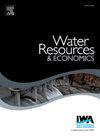环境流政策对电力系统平衡成本和河流生态系统服务效益的影响
IF 1.9
3区 经济学
Q2 ECONOMICS
引用次数: 0
摘要
可持续的河流管理需要更多关于环境流量限制的成本和收益的信息。本文以北欧电力市场和生态系统服务现状为研究对象。我们对位于Kemijoki河的水电站施加了更严格的流量斜坡约束,并量化了环境流量政策对水电平衡服务、河流水力学和生态系统服务的影响。研究发现,环境流量政策越严格,水电运营商的最优平衡市场灵活性水平越低。此外,一项水文流量分析表明,该政策带来了生态改善。我们比较了环境流量政策的成本和收益。研究结果表明,成本、水电收入损失和增加的系统平衡成本与为改善环境而支付的意愿相当。如果能够在不增加二氧化碳排放的情况下实现系统平衡,那么为改善河况买单的意愿就会增加,从而扩大了当地利益与系统成本之间的差距。这项研究的见解可以让决策者和私营公司更好地将环境问题纳入受监管河流的管理中,同时承认水电在电力系统中的价值。本文章由计算机程序翻译,如有差异,请以英文原文为准。
Impact of environmental flow policy on power system balancing costs and river ecosystem service benefits
Sustainable river regulations require more information on the costs and benefits of environmental flow constraints. This paper presents a case study focusing on the Nordic electricity market and ecosystem service situation. We impose tighter flow ramping constraints on a hydropower plant situated in the Kemijoki River and quantify the effects of the environmental flow policy on hydropower balancing services, river hydraulics and ecosystem services. Our findings reveal that as the environmental flow policy becomes more stringent, the optimal level of balancing market flexibility for the hydropower operator decreases. In addition, a hydrological flow analysis indicates that ecological improvements resulted from the policy. We compare the costs and benefits of the environmental flow policy. The findings indicate that the costs, hydropower revenue loss and increased system balancing costs are comparable to the willingness to pay for environmental improvements. If system balancing can be achieved without an increase in emissions, the willingness to pay for the improved river state increases, widening the gap between local benefits and system costs. The study insights can inform policymakers and private companies to better incorporate environmental concerns in the management of regulated rivers while acknowledging the value of hydropower in the power system.
求助全文
通过发布文献求助,成功后即可免费获取论文全文。
去求助
来源期刊

Water Resources and Economics
Environmental Science-Water Science and Technology
CiteScore
5.00
自引率
0.00%
发文量
17
审稿时长
51 days
期刊介绍:
Water Resources and Economics is one of a series of specialist titles launched by the highly-regarded Water Research. For the purpose of sustainable water resources management, understanding the multiple connections and feedback mechanisms between water resources and the economy is crucial. Water Resources and Economics addresses the financial and economic dimensions associated with water resources use and governance, across different economic sectors like agriculture, energy, industry, shipping, recreation and urban and rural water supply, at local, regional and transboundary scale.
Topics of interest include (but are not restricted to) the economics of:
Aquatic ecosystem services-
Blue economy-
Climate change and flood risk management-
Climate smart agriculture-
Coastal management-
Droughts and water scarcity-
Environmental flows-
Eutrophication-
Food, water, energy nexus-
Groundwater management-
Hydropower generation-
Hydrological risks and uncertainties-
Marine resources-
Nature-based solutions-
Resource recovery-
River restoration-
Storm water harvesting-
Transboundary water allocation-
Urban water management-
Wastewater treatment-
Watershed management-
Water health risks-
Water pollution-
Water quality management-
Water security-
Water stress-
Water technology innovation.
 求助内容:
求助内容: 应助结果提醒方式:
应助结果提醒方式:


